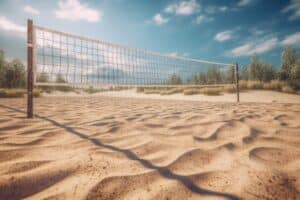How to Build a Sand Volleyball Court in Your Backyard
Key Takeaways
- The recommended size for a standard sand volleyball court is 50′ x 80′, including a safety space of 10 feet in each direction.
- To mark the boundaries of the court, brightly colored tape or rope can be used.
- Proper site preparation, including excavation and drainage, is crucial for building a sand volleyball court.
If you’re a volleyball enthusiast and have a spacious backyard, why not create your own sand volleyball court? Imagine the convenience of being able to practice and play whenever you want, without having to travel to a public court. In this article, we will provide you with a detailed guide on how to build a sand volleyball court in your backyard. So let’s get started!
Determining the Playing Area
The first step in building a sand volleyball court is to determine the playing area. The recommended size for a standard court is 50′ x 80′, which includes a safety space of 10 feet in each direction. It’s important to ensure that the area is level and free of obstructions such as tree branches or power lines. If you have limited space, smaller courts can also be built.
Court Dimensions
Once you have determined the playing area, it’s time to mark out the court dimensions. A standard sand volleyball court measures 29’6″ x 59′, which is measured from the outer edge of the boundary lines. However, if you prefer a smaller court for 2-on-2 games, the size can be reduced to 26’3″ x 52’6″. To mark the boundaries, you can use brightly colored tape or rope that is easily visible.
Site Preparation
Before you start excavating the court area, it’s important to call 811 to check for any underground utilities. This is crucial to avoid any potential accidents or damage to utility lines. Once you have clearance, you can proceed with excavating the court area to a depth of 1.5 to 3 feet, depending on the drainage requirements of your location. Installing drainage ditches and perforated drainage pipes will help ensure proper drainage.
Court Drainage
After excavating the court area, it’s time to address the issue of drainage. Overlaying the court area with pea gravel, ranging from a few inches to a foot thick, will assist with drainage. The amount of pea gravel required will depend on the drainage requirements of your location. On top of the pea gravel, you should place Sand Preservation FabricTM to prevent the sand from washing through. This fabric can be purchased from VolleyballUSA.com.
Sand Selection and Installation
Now comes the exciting part – selecting the sand for your court. It’s important to find high-quality sand that is suitable for volleyball. You can contact local sand companies or suppliers to purchase the sand required. The amount of sand needed will depend on the depth and size of your court. Spread the sand evenly over the court area, ensuring a thickness that prevents players from contacting the underlying surface. Use a level to ensure the sand is level and smooth.
Net and Accessories
Once you have installed the sand, it’s time to set up the net and other accessories. Install a volleyball net system according to the manufacturer’s instructions. The official net height for men is 7′ 11 5/8″ and for women is 7′ 4 1/8″. Co-ed competition is played on a men’s height net. You can also consider adding additional accessories like boundary lines, padding, and antennas for a professional touch.
It is important to note that building a sand volleyball court requires careful attention to detail and proper installation. It is recommended to consult with professionals or experienced individuals to ensure safety and proper construction. By following these steps, you can create a backyard sand volleyball court that will provide endless hours of fun and enjoyment for you, your family, and your friends.
Related Websites:
FAQs:
Q: What are the benefits of having a sand volleyball court in my backyard?
Having a sand volleyball court in your backyard provides a convenient and accessible space for volleyball enthusiasts to enjoy the game. It allows for regular practice, social gatherings, and friendly competitions with friends and family. Additionally, playing on sand can be easier on the joints and reduce the risk of injuries compared to playing on harder surfaces.
Q: How do I determine the ideal location for the sand volleyball court?
To determine the ideal location for your sand volleyball court, consider factors such as available space, proximity to the house and amenities, and ensuring there is enough clearance around the court. It’s also essential to evaluate any potential obstacles or hazards, such as trees, roots, or underground utilities.
Q: What materials and tools do I need to build a sand volleyball court?
To build a sand volleyball court, you will need materials such as sand, wooden planks or alternative border materials, and boundary markers. The necessary tools include a shovel, level, tape measure, and other basic construction tools. The material options can be adjusted based on your budget and availability.
Q: How do I properly maintain and care for my backyard sand volleyball court?
Regular maintenance of your sand volleyball court is essential to keep it in good condition. Tasks include raking and watering the sand to prevent compaction and maintain proper moisture levels. To prevent weeds, you can use weed control methods or install a geotextile fabric under the sand. It’s also important to periodically inspect the court for any signs of erosion or damage and make necessary repairs.
Q: What are some tips for spreading and leveling the sand on my volleyball court?
When spreading and leveling the sand on your volleyball court, it’s important to start with a flat and well-compacted base. Begin by evenly distributing the sand across the court and then use a rake or a drag mat to level it. Use a level to ensure a consistent depth throughout the court. It may also be helpful to wet the sand slightly to improve its workability and prevent excessive movement during play.






